The football card was the inferior cousin of the baseball card in the 1960s. They were taken less seriously by Topps and other companies. Football was a mess during this decade. The American Football League challenged the NFL and signed some top players. That led to some weakness and instability.
There was freedom and informality in 1960s football cards that we wouldn’t see later. The schismatic uncertainty in football during this decade had a happy ending. The two leagues competed in the first Super Bowl in 1967, and the AFL was incorporated into the NFL. There was a significant battle over card rights between Topps and Fleer.
These cards testify to a time when the game wasn’t big money. But rather enjoying the game and beating up your rivals.
1960 Fleer Harvey White #1

A PSA 9 sold for $10,010.
The 1960 Fleer cards had beautiful lettering with perfect 1960s panache. As you can see, the main problem they had was the poor green screen quality of disembodied people floating in space. And that lousy cutting typified many of these early 1960s football cards, particularly Fleer ones. But the Harvey White action pic is so perfect that it makes up for ## that flaw. Indeed, it looks good on that weird blue first season of Star Trek background. All this makes the 1960 Fleer Harvey White #1 a classic.
Aside from its striking look, the card is also surprisingly valuable. It was often mangled and miscut because it was the #1 card in the series. So, getting a copy in good condition is quite a challenge.
1968 Topps Bob Griese #196
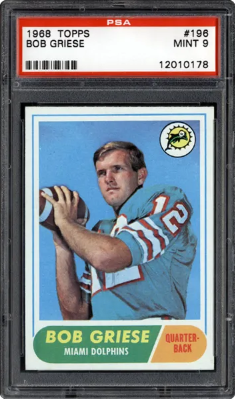
A PSA 9 sold for $2,520.
As I was saying, the second design in 1968 Topps Football was clean, and this is my favorite card in the set. The 1968 Topps Bob Griese #196 is a perfect rookie card, featuring a quarterback seemingly out of central casting. But what really makes this card work, is the way the blue background plays off the Dolphin uniform shade of the same color.
It should conflict, but they complement each other. And of course, Bob Griese is a Hall of Famer with two Super Bowl victories to his name. Therefore, this card is worth quite a bit in good condition.
1969 Topps Billy Cannon #68
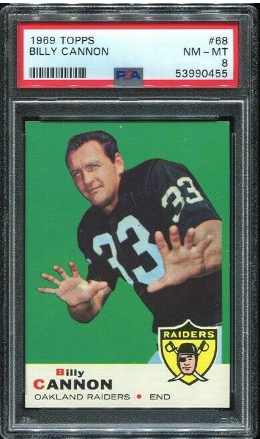
A PSA 8 sold for $53.
Football card designs in the 1960s started with ugly colored “green screen” types of backgrounds. Then became increasingly sophisticated and beautiful…before going all the way back. So, the 1969 Topps Footall cards design was not their best. Even the 60s-style lettering here is kind of meh.
Nonetheless, the 1969 Topps Billy Cannon #68 card just pops. Is it the wry, sarcastic look on Billy Canon’s face? The inexplicable use of what can only be described as jazz hands? Or is it the irrepressible Raiders logo that makes it all look absurd? A card with these disparate and incongruent elements should not work. But it does. By the way, Billy was a Heisman Trophy winner and a three-time AFL champion. So, he had plenty of talent to back up that attitude.
1968 Topps Kent McCloughan #12
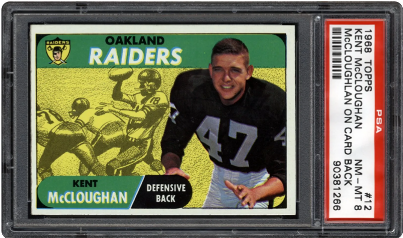
A PSA 8 sold for $66.
Once again, the Oakland Raiders for the win. The 1968 football cards design is probably the second best Topps came up with, after their wonderful 1962 variety. There were the ones like the 1968 Topps Kent McCloughan #12 card, with an action sketch to the right. Then another cleaner design. Both were beautiful and made the Topps 1968 Football a great set, worthy of the first in years to include AFL and AFC players.
This card is particularly fetching because, let's face it, Kent has a winning smile and is fresh off getting a great buzz cut. He looks like someone who will break your hip bone and then hold your hand on the way to the hospital.
1963 Topps Jim Marshall Rookie Card #107
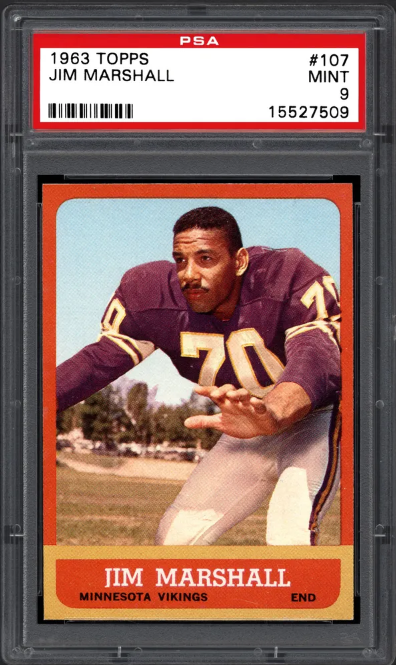
A PSA 9 sold for $1,025.
The 1962 Topps Football cards design is simply unbeatable. So, I appreciate the fact that Topps just didn’t try. Instead, they went for a more straightforward design the following year. As you can see here, it certainly works. The borders are clean, and the lettering has a beautiful color scheme, especially on this card.
I didn’t select the 1963 Topps Jim Marshall Rookie Card #107 because it's Jim’s first card. Although that helps make it more significant. Instead, it's a gorgeous shot and shows how immensely assured the 2-time pro-bowler was from the get-go. Jim Marshall looks at every part of the grizzled veteran in this card.
1962 Fleer Jack Kemp #79
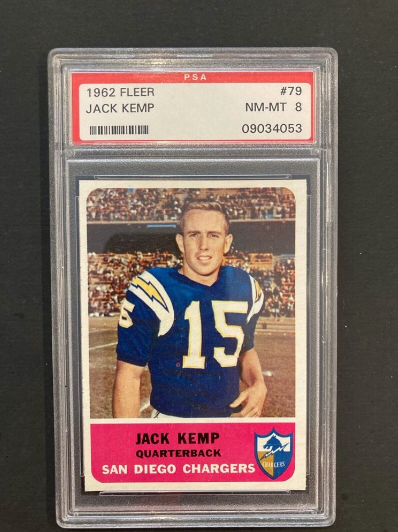
A PSA 8 sold for $98.
Look at the 1962 Fleer Jack Kemp #79 card closely. Now imagine if Jack was wearing a cowboy hat and had a gun in his holster. Perfect Western poster, right? This picture catches Jack Kemp as the All-American hero. And the beautiful background of the stands only emphasizes the heroic shot.
Kemp became Housing Secretary for George H. W. Bush later in life. He even ran for President unsuccessfully. Any guy who was a 7 time AFL All-Star, twice champion, and a cabinet member deserves props.
1962 Topps Mike Ditka Rookie Card #17
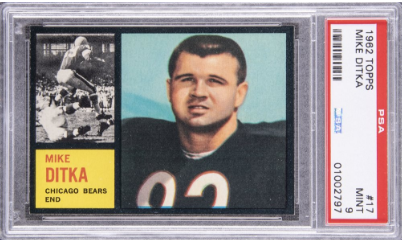
A PSA 9 sold for $94,710.
The words Mike Ditka and beautiful are not often found in close proximity. Sorry, Mike, we love you anyway. Still, anything that appears in the stunning 1962 Topps football release is gorgeous. And in that little black-and-white photo to the left, we see Mike jumping over a tackle in a remarkable action shot. The picture of Ditka shows him in an earnest pose. The entire look of the 1962 Topps Mike Ditka Rookie Card #17 is appealing.
And, of course, the outsized career Ditka enjoyed as a Super Bowl-winning player AND coach also provides this gorgeous card with a substantial amount of market value. “Iron Mike" remains one of NFL history's most potent and successful personalities. This card is where it all started.
1963 Fleer Lance Alworth Rookie Card #72
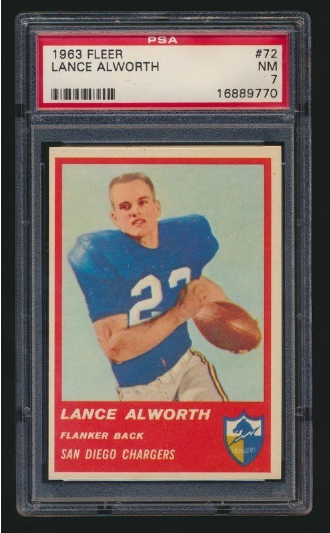
A PSA 8 sold for $1,860.
Does anything scream white privilege more than a good-looking blonde football star from the 1960s named Lance? But you can’t deny the Wonderbread and mayonnaise charm of the 1963 Fleer Lance Alworth Rookie Card #72. It is the quintessential classic image of the old-school American athlete. The design of 1963 Fleer Football cards was simple, but it pops.
Lance was nicknamed “Bambi” because of his delicate looks and fleetness of foot. He is the first Hall of Famer selected despite playing his best years in the AFL for the San Diego Chargers, though Alworth did win a Super Bowl with the Dallas Cowboys.
1967 Topps Lance Alworth #123
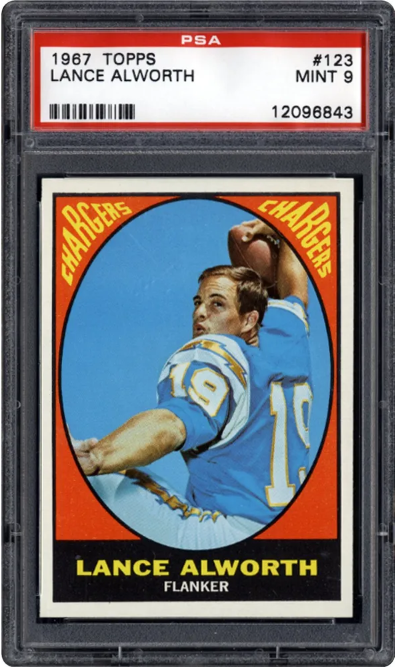
A PSA 9 sold for $454.
I can’t help it if Lance Alworth is the most photogenic player of the decade. Take it up with genetics. The 1967 Topps Football cards design wasn’t all that great. Most of the cards just don’t work. It's that small lettering in the top corners and colors seemingly chosen at random that undermine the release.
But they couldn’t do Alworth like that, so they put his dynamic pose in a beautiful combo of colors for a superior card. And the Chargers had already adopted those gorgeous lightning bolts, and they add that final touch to the masterpiece that is the 1967 Topps Lance Alworth #123 card.
1962 Topps Matt Hazeltine #160
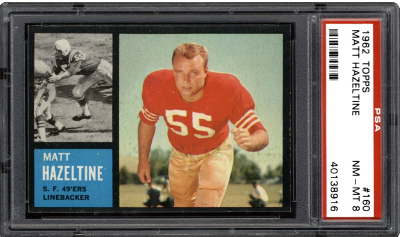
A PSA 8 sold for $155.
I hope you like the 1962 Topps Football design because I am not done with it here. This is the best design of the decade, not just in this sport but in all of them. And kudos to Topps for not making similar cards for the different sports. That allows us to enjoy this absolutely beautiful design.
And while the 1962 Topps Matt Hazeltine #160 is not particularly valuable or essential, boy, does it pop. It looks like Matt is posing for a movie poster. But because the pose is so obviously fake, it becomes a camp classic. And, of course, the action shot to the left reminds us that Hazeltine was a real football player. A two-time pro-bowler as well. But he missed out on a possible Hollywood career.
1960 Topps Jim Brown #23
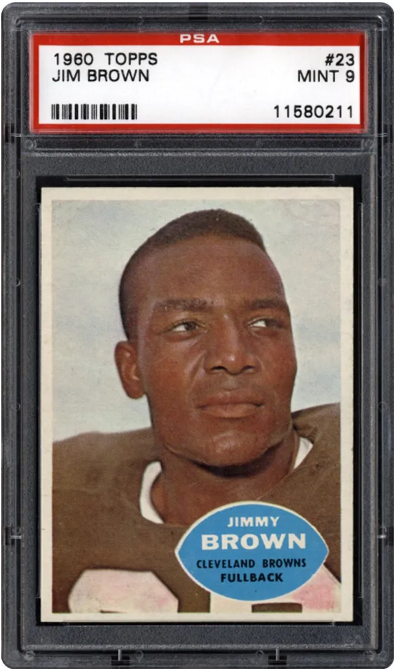
A PSA 9 sold for $10,010.
The recent passing of Jim Brown left us with a lot to unpack. He was the best running back of all time and one of the best football players ever. A civil rights activist of note, not the greatest human being.
Nonetheless, there is no questioning his incredible importance in the sport and his standing as (without a doubt) the best player of the 60s. His iconic rookie card appeared in 1958 and cannot be considered for this list of beautiful football cards of the 1960s. But while the first card showcased his athleticism, the 1960 Topps Jim Brown #23 card signifies his power and strength. It is a reminder of why catching up to Jim was just the first (nearly impossible) task; then, you had to try and bring this behemoth down.
1966 Philadelphia Gary Lewis #178
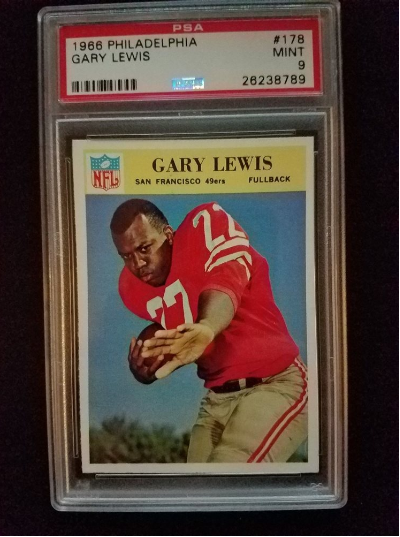
A PSA 9 sold for $90.
How is this wonderful card worth so little? The 1966 Philadelphia Gary Lewis #178 card has the protagonist going all out in doing cool poses for the cameraman. The colors play off each other beautifully, and that rich blue sky is full of promise and possibility. What a wonderful, beautiful 1960s football card.
1962 Topps Ernie Davis Rookie Card #36
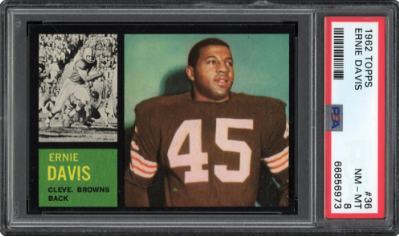
A PSA 8 sold for $4,041.
The stunning design of the 1962 Topps Ernie Davis Rookie Card #36 speaks for itself. The 1962 Topps Football design, with its unique three-square design, is the 1960s most beautiful football card design. The inspiring picture of Ernie Davis, shoulders straight, ready to take on the world, is nothing short of inspiration.
But what makes this card so unique is the unique story behind his career. Davis was the number-one pick in the 1962 Draft. The Browns brought him in to create a dynamic duo with Jim Brown, who wore the same number at Syracuse. But it wasn’t to be. The half-back was diagnosed with leukemia and died at the age of 23. This beautiful card is a poignant reminder of what we all lost.
1965 Topps Joe Namath Rookie Card #122
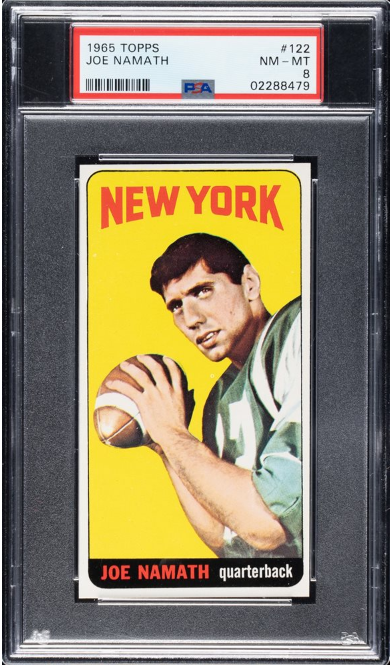
A PSA 9 sold for $264,000.
In 1969, Joe Namath was the biggest incoming star for the AFL, then in its last year as a separate league. The funny part is that Topps lost its rights to the NFL in 1965 and was forced to move to the AFL.
But they will be thankful they did because the 1965 Topps Joe Namath Rookie Card #122 is widely recognized as the most extensive and most valuable (though, in our opinion, not the most beautiful) football card of the 1960s. After all, “Broadway Joe” defined the early Super Bowl era.
1966 Philadelphia Gale Sayers Rookie Card #38
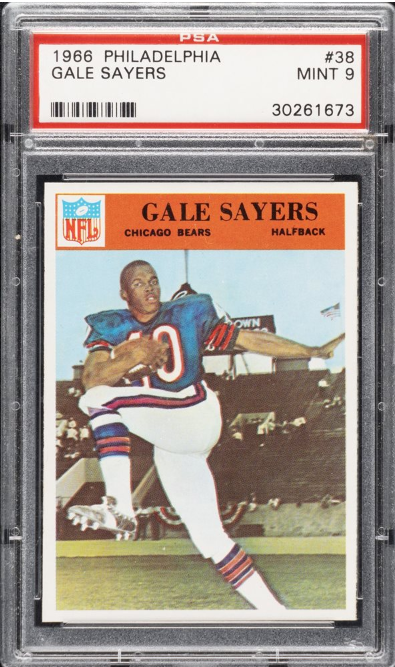
A PSA 9 sold for $58,800.
The iconic 1966 Philadelphia Gale Sayers Rookie Card #38 is the decade's most beautiful and crucial football card. Everyone who saw Gale Sayers play agreed no one ever ran better with a football than this player. But he was also a remarkable receiver and kick returner. He was the 1965 Rookie of the Year.
Unfortunately, the “Kansas Comet” had his career cut short by injury, but his grace on the gridiron is immortal. The Heisman Trophy pose in this picture captures the remarkably confident athlete at the peak of his unparalleled powers. And man, do those colors pop.
Final Word On Beautiful Football Cards from the 1960s
1960s football card buffs may notice that I did not give any daylight the 1965 Topps Football release. The reason is apparent. It's a cheap knockoff of the 1955 Bowman Baseball release. Therefore, all of those cards look terrible.
But aside from that trainwreck of a release, 1960s football cards offer an incredible variety of designs and possibilities. There are classic sets from Fleer, Topps, and Philadelphia. All the competition and excitement brought about inventive designs and choices. Indeed, it's fair to say that there is more creativity here than in their baseball equivalents. And the most remarkable thing is that some of the most beautiful cards here are dirt cheap. Why is good art always unappreciated?